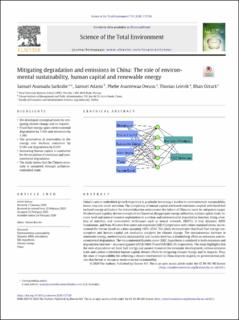| dc.contributor.author | Sarkodie, Samuel Asumadu | |
| dc.contributor.author | Adams, Samuel | |
| dc.contributor.author | Owusu, Phebe Asantewaa | |
| dc.contributor.author | Leirvik, Thomas | |
| dc.contributor.author | Ozturk, Ilhan | |
| dc.date.accessioned | 2020-07-08T13:10:11Z | |
| dc.date.available | 2020-07-08T13:10:11Z | |
| dc.date.created | 2020-03-04T00:23:26Z | |
| dc.date.issued | 2020 | |
| dc.identifier.citation | Sarkodie, S. A., Adams, S., Owusu, P. A., Leirvik, T. & Ozturk, I. (2020). Mitigating degradation and emissions in China: The role of environmental sustainability, human capital and renewable energy. Science of the Total Environment, 719: 137530. doi: | en_US |
| dc.identifier.issn | 1879-1026 | |
| dc.identifier.uri | https://hdl.handle.net/11250/2661448 | |
| dc.description.abstract | China's carbon-embedded growth trajectory is gradually becoming a burden to environmental sustainability, hence, requires much attention. The complexity of human capital attributed emissions coupled with fossil fuel inclined energy utilization for industrialization underscores the failure of China to meet its mitigation target. We developed a policy-driven conceptual tool based on disaggregate energy utilization, human capital, trade, income level and natural resource exploitation in a carbon and environmental degradation function. Using a battery of statistics and econometric techniques such as neural network, SIMPLS, U test, dynamic ARDL Simulations, and Prais-Winsten first-order autoregressive [AR(1)] regression with robust standard errors, we examined the theme based on a data spanning 1961–2016. The study demonstrates that fossil fuel energy consumption and human capital are conducive catalysts for climate change. The instantaneous increase in renewable energy, environmental sustainability and income level has a diminishing effect on emissions and environmental degradation. The environmental Kuznets curve (EKC) hypothesis is validated in both emissions and degradation function — at a turning point of US$ 5469.79 and US$ 5863.70, respectively. The study highlights that the over-dependence on fossil fuel energy and natural resources for economic development, carbon-intensive trade and carbon-embedded human capital, thwart efforts to mitigating climate change and its impacts. Thus, the onus of responsibility for achieving a cleaner environment in China depends majorly on governmental policies that favour or dampens environmental sustainability. | en_US |
| dc.language.iso | eng | en_US |
| dc.publisher | Elsevier B.V. | en_US |
| dc.rights | Attribution-NonCommercial-NoDerivatives 4.0 Internasjonal | * |
| dc.rights.uri | http://creativecommons.org/licenses/by-nc-nd/4.0/deed.no | * |
| dc.title | Mitigating degradation and emissions in China: The role of environmental sustainability, human capital and renewable energy | en_US |
| dc.type | Peer reviewed | en_US |
| dc.type | Journal article | en_US |
| dc.description.version | publishedVersion | en_US |
| dc.rights.holder | © 2020 The Author(s) | en_US |
| dc.subject.nsi | VDP::Samfunnsvitenskap: 200::Samfunnsgeografi: 290 | en_US |
| dc.subject.nsi | VDP::Samfunnsvitenskap: 200::Økonomi: 210 | en_US |
| dc.source.pagenumber | 14 | en_US |
| dc.source.volume | 719 | en_US |
| dc.source.journal | Science of the Total Environment | en_US |
| dc.identifier.doi | 10.1016/j.scitotenv.2020.137530 | |
| dc.identifier.cristin | 1799464 | |
| dc.description.localcode | Unit Licence Agreement | en_US |

